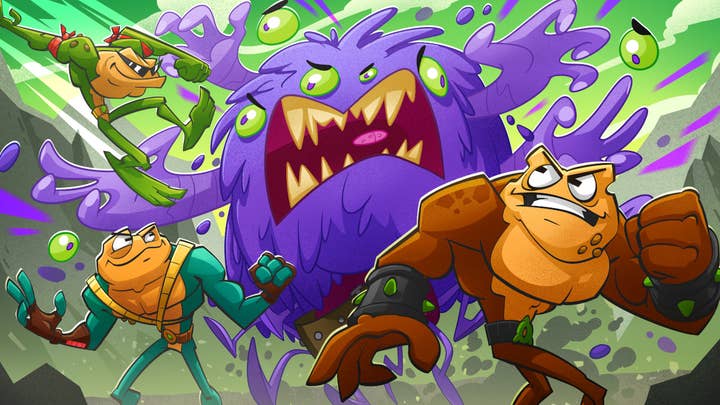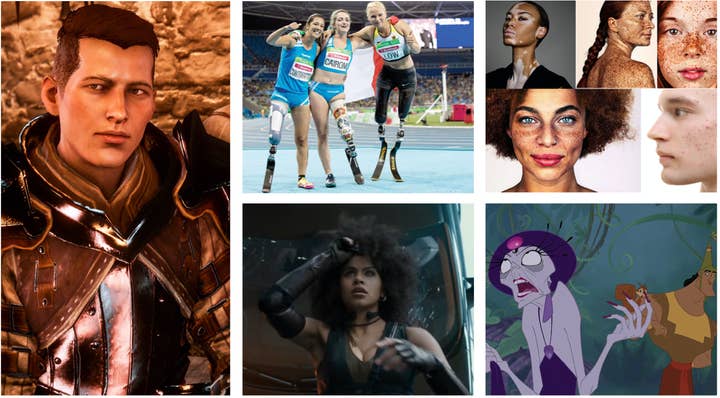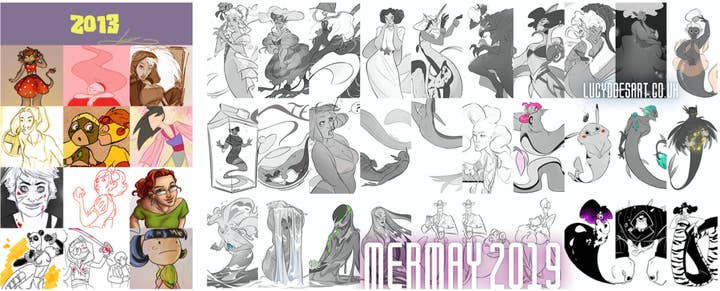How to be a better character designer
At the Yorkshire Games Festival, Lucy Kyriakidou explored visual storytelling, body diversity, and how to improve your art skills
Character design is a cruel world.
Creating protagonists for any medium means that your work will likely be front and center. Being in the spotlight can be immensely gratifying, but one small mistake and fans will throw you under the bus and leave you no choice but to start from scratch -- as the team behind the Sonic movie did.
Character art is a very competitive line of work in the games industry, and finding your feet in this ruthless field can be overwhelming for a young artist. Which is why freelance artist Lucy Kyriakidou, who most recently worked as lead character designer on Battletoads, decided to share the lessons she's learnt on how to improve your craft.
In a Yorkshire Games Festival talk called 'Lucy's character design playlist', she broke down the process she's put in place in over a decade of working in games.
"I think the only way to tackle something like this is to ask: what makes a good character design?," she said. "It's not just a good character. What is the whole process like as a character designer? What are the factors that affect it in order to come up with a great result?"
Based on her experience, the answer to this question is three things:
- The brief, and how you develop that narrative in a creative way
- The human factor, which is your interpretation as a designer
- Your art skills, how well you can draw and put what's in your head on a piece of paper

Visual storytelling
At its most basic level, being a good character designer is linked to how closely you can follow the brief that is given to you. You will be asked for specific characteristics and it is your job to bring them to life.
"But it is a lot more than that," Kyriakidou said. "It is what you bring into the brief itself, yourself. A character designer's job is to interpret the story, but also develop it in a visual and creative way. This may seem obvious but I've seen countless designs from young artists where they went crazy and then they tried to justify how that fits the brief, when it was simply just what they wanted to draw."
To both fit the brief and contribute to the narrative with your character design, start by researching the subject given to you and create some mood boards. This will help you get a better understanding of the topic, and ground your design in reality and facts so you can make deliberate design decisions.
"This doesn't only apply to designs that need to be realistic," Kyriakidou continued. "We need to have recognisable elements for any design to succeed in conveying a message, no matter how alien [the] creature you're [drawing]."

During the research phase, you may come across details that you may have otherwise not considered, things that you can use to think about what your character knows and how they live.
That includes:
- Surroundings
- Personality
- Routine
- Backstory
- Goals
- Foreshadowing
- Movement
"Visual storytelling is basically the core of what a character designer does," Kyriakidou said. "The job isn't to create the most intricate designs, but to tell a story and manipulate the assumptions people make when they see what you create."
When it comes to surroundings, taking into consideration where the character is and how that affects how they look is an important aspect. It could be as simple as having them wear a coat because it's chilly outside. But it could also be that you're designing a character that lives on a lava planet and as a result their skin is made of rock, Kyriakidou explained.
"The job [is] to tell a story and manipulate the assumptions people make when they see what you create"
Thinking about the different ways your character is expressing their identity is another way to add some personality.
"I personally [express my personality] through my clothes, but also my hair. Some people have tattoos. But it's not just about your personal expression, it's about other traits. Somebody may be accident prone, and have plasters all over their face. Or your character may like sweets a lot so they keep a bag of them in their back pockets at all times.
"Just think about their lifestyle. Maybe they need to keep a pen on them to take notes for work. Try to think of these situations where people need to have something for convenience. For example, all my coat pockets have poop bags in them because I have a dog. You can tell a lot about a person's life by looking at them or searching through their pockets."

When looking at your character's past and how that can influence what they look like, it doesn't necessarily mean focusing on their upbringing or culture. It can be focusing on something as simple as a recent injury or maybe their hair is slightly damp because they had a shower a short while ago.
"It's the same when it comes to goals," Kyriakidou continued. "It could be a big life aspiration or something smaller, like they're carrying a wallet because they want to buy a donut, or maybe they're carrying a knife because they want to shiv this one enemy. It's all things that the brief won't tell you, the little touches; this is up to you to consider and that's where research is important."
And when thinking about your character's culture, you do need to go beyond the obvious to avoid falling into clichés.
"People are a lot more than what they wear, they are traditions and cultural [practices]"
"[Look] at all aspects of that culture and I mean not just clothes. Because people are a lot more than what they wear, they are traditions and cultural [practices]. Obviously if you have somebody to talk to, that is great, because the best way to represent somebody is to listen to the voice of the person that you're trying to represent."
Finally, Kyriakidou highlighted her personal preference for adding little foreshadowing elements so the player can feel rewarded by figuring it out, and creating dynamic characters, as she has a background in animation. You can convey a lot of your character's personality by showing how they move and how they interact with the world and others. Indicating how the character might move is also a great way to have your vision carried through to later stages of development.
She also reminded young designers to always keep in mind the technical constraints and how small their character may be appearing in-game.
Bringing diversity to your work
A crucial aspect of improving your work as a character designer is what Kyriakidou called the human factor, which is how you naturally bring your own ideals and experiences to what you draw. Learning to go beyond your own ideals will help you grow as an artist.
"In my career, as I progressed, I wanted to find ways to become better and I was very eager to practice, and work towards where I wanted to be as an artist. And the first step to do that is reviewing the work -- review your work to find any patterns that limit your design skills or are just recycling old ideas.
"Review your work to find any patterns that limit your design skills or are just recycling old ideas"
"This brought me to the general lack of diversity. I was drawing, like most of us do, what [I] found is aesthetically appealing, and I realised that was very limited. And I realised that my idea of beauty was limited because I had internalised ideals that were fed to me through consumption of games, cartoons, comics and general popular media -- and society itself. And I was passing on this bias through my art, the way that it was passed on to me."
Since realising this, Kyriakidou started consciously working on removing that bias and bringing something new to the table instead of recycling existing ideals. She said it did not only improve her skill level, but her own relationship with herself and others.
She also noted that it's crucial to challenge the status quo for main protagonists in particular, and not just to apply diversity to secondary characters.

"Some ways to do that is to reference real life. Going back to research, we need to stop making assumptions on what someone looks like. If we're trying to figure out a character's body shape, for example, we need to rely on facts that may have affected it and always refer back to real life, and referencing real people.
"Avoid developing a default that all your designs stem from. For artists that means studying and changing the way you do personal work. Go back to those storytelling points that I mentioned before and think of interesting ways to interpret the brief that are outside your comfort zones, in order to expand that comfort zone."
One great resource to study bodies and how their shapes can change depending on the person's background is to look at Howard Schatz's athlete pictures, which were also gathered in a book simply called Athlete.
"Avoid developing a default that all your designs stem from"
Kyriakidou also recommended trying to redesign existing characters. It's a good exercise to think about the different factors that could affect the character's body in a more conscious way, trying to differentiate it from what their image currently is. Try to surround yourself with diverse images as well.
"It is as easy as looking at the people you work with or your family," she said. "Let real life relationships and experiences create a positive bias and link traits to people that you like. What is important to know, while I talk about diversity, is that it is not just about race or weight. It is the way we show age -- if we show it -- or it can be skin deep. I know for a fact that spots are not just for awkward teens. It is about gender diversity. What if your character is trans or non-binary? Are we showing these characters? Are they transitioning? What if they decide to not alter their looks? Do we represent disabilities? And do we represent something as small as body hair on women?"

If you're somehow finding it difficult to think of a reason why this matters, Kyriakidou has an uncomplicated answer: it is simply the right thing to do. If that's not enough to convince you, she mentioned an EA study showing that people are more likely to play inclusive games. Similar research by Newzoo shows the same sentiment: diversity sells.
"Social responsibility is a reason I truly believe in. We're an industry that reaches millions of people, so the impact of our work is something that we can't not take into consideration. And this feeds into more accurate representation and relatability for our players. We have such a diverse audience that we are doing it a disservice by not representing it.
"Think of all the ways, all the times that you saw a character that you could not relate to in a game. On a personal note, I've not played some amazing looking games because of male protagonists fatigue. And I know for a fact I'm not the only one."
Improving your art skills
Lastly, when it comes to character design, it's important to develop artistic skills in a variety of areas, like anatomy and proportions -- and not just when it comes to humans. Kyriakidou asks artists to consider whether they can draw a horse, confessing that she "can [only] do a very chubby, silly-looking horse."
Unfortunately, there is only one solution.
"Practice," she says. "I cannot hear you all but I imagine there was a sigh from every artist. I would like to highlight that this doesn't mean draw every day because you can be doing that and be learning nothing. So how do you expect to improve?"
For your personal studies, start with life drawing, she advised. It is simply the best way to improve and, through repetition, boost your observation skills, your understanding of the subject, and your muscle memory.
There are fun ways to practice, such as doing challenges that are typically organised on social media, like 'draw this in your style' challenges. Kyriakidou also took part in a mermaids challenge that offered artists to draw different types of mermaids every day for a month, and she also practiced her character design based on photos people sent her on Twitter.

"It was a great exercise, and it was interactive. So that made it ten times more fun for me. Find ways to make this an experience to enjoy is what I'm saying; it is the best way to learn. Check up things other than games, cartoons and drawn art. Fashion is one thing that you should be studying. I bought a book recently on historical costume design and it changed my life forever. Sculpture, dance and makeup [are] things that you should be studying and taking inspiration from.
"On the other hand, you should keep it structured as well. Focus on one thing at a time, even if it takes a few months, that's okay. If you try to do everything at once, you will get overwhelmed, and you'll get to a point where you feel failure and give up. And this is not me just saying it, I have been there and impostor syndrome is real, so don't set yourself up for failure."
"Focus on one thing at a time, even if it takes a few months, that's okay"
One way to avoid burnout is to reach out to fellow artists. Finding a mentor or simply someone to talk to about your issues can help you learn faster and give you a better understanding that you typically can't find in books or tutorials. Asking for portfolio feedback for instance is an important step to improving your skills.
"Don't underestimate the importance of asking questions and asking for reviews," Kyriakidou said. "And please take your time. I mentioned that mindlessly drawing daily won't help you, but studying hard every day, with no breaks, won't do any good either. If not for your own personal mental health, that you should be prioritising, looking at something with fresh eyes is a game changer. I do it at work all the time. I have to leave something and look at it the next day to see if it's still where I thought it was.
"So to summarise: do your homework, level up your research game, and expand your visual library to become a better character designer and, hopefully, a happier and more understanding person."
More GamesIndustry.biz Academy guides to Making Games
Our guides to making games cover various aspects of the development process, whether you're a young game developer about to start a new project or an industry veteran:









